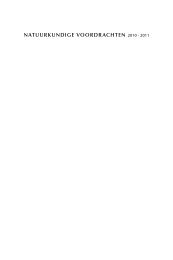Jaarboek no. 87. 2008/2009 - Koninklijke Maatschappij voor ...
Jaarboek no. 87. 2008/2009 - Koninklijke Maatschappij voor ...
Jaarboek no. 87. 2008/2009 - Koninklijke Maatschappij voor ...
Create successful ePaper yourself
Turn your PDF publications into a flip-book with our unique Google optimized e-Paper software.
Diligentia 131<br />
The regulatory response inhibiting allergic inflammation.<br />
In a study carried out in Gabonese schoolchildren, it has been shown that children with<br />
an increased parasite induced IL-10 production had a decreased risk of being atopic to<br />
house dust mite. The inhibitory cytokine, IL-10, is indeed up regulated during chronic<br />
helminth infections, and has been shown to be able to inhibit basophil degranulation.<br />
Therefore, it is plausible that during helminth infections regulatory responses and suppressory<br />
cytokines such as IL-10, inhibit the inflammatory process that eventually leads<br />
to allergic disease outcome, as suggested in the diagram. However, several questions such<br />
as whether high levels of IL-10 are present in tissues where mast cells reside, how does<br />
the IL-10 reach these tissues and does it work in an antigen specific manner, need to be<br />
addressed before this model is accepted.<br />
Immu<strong>no</strong>-epidemiological studies have the problem that it is impossible to control for all<br />
confounders. Therefore, it is extremely valuable, if possible, to use animal models and well<br />
controlled conditions to prove whether a finding can be confirmed in the experimental<br />
system.<br />
To study the causal relationship between helminth infections and the development of<br />
allergic diseases, several research groups have developed combined murine models of<br />
infection and asthma. Either house dust mite antigen or a model antigen (e.g. ovalbumin)<br />
is used to induce airway inflammation that involves eosi<strong>no</strong>pilic infiltration. This model is<br />
then used to study the effect of helminth infections on the development of airway allergies.<br />
Studies with Schistosoma mansoni have demonstrated that this infection, at the chronic<br />
stage, leads to strongly reduced eosi<strong>no</strong>philic airway inflammation. Interestingly, during<br />
the acute phase of infection, there was <strong>no</strong> suppression of the inflammatory response to<br />
allergen and if anything, there seemed to be an enhanced eosi<strong>no</strong>phil recruitment into the<br />
lungs of acutely infected mice. The latter supports the <strong>no</strong>tion that only chronic helminth<br />
Immu<strong>no</strong>logie van de hygiëne-hypothese<br />
Histamine,<br />
leukotrienes,<br />
prostaglandins




